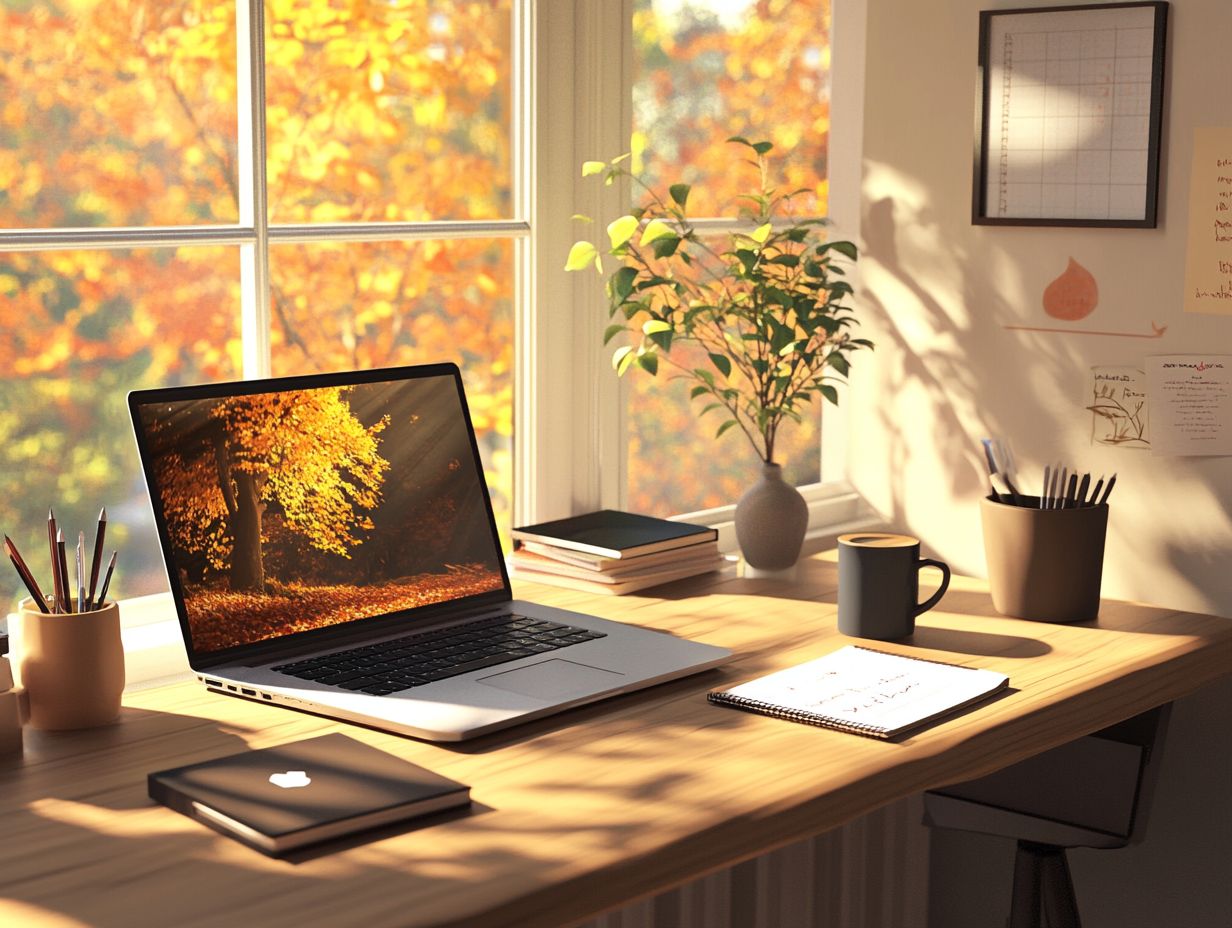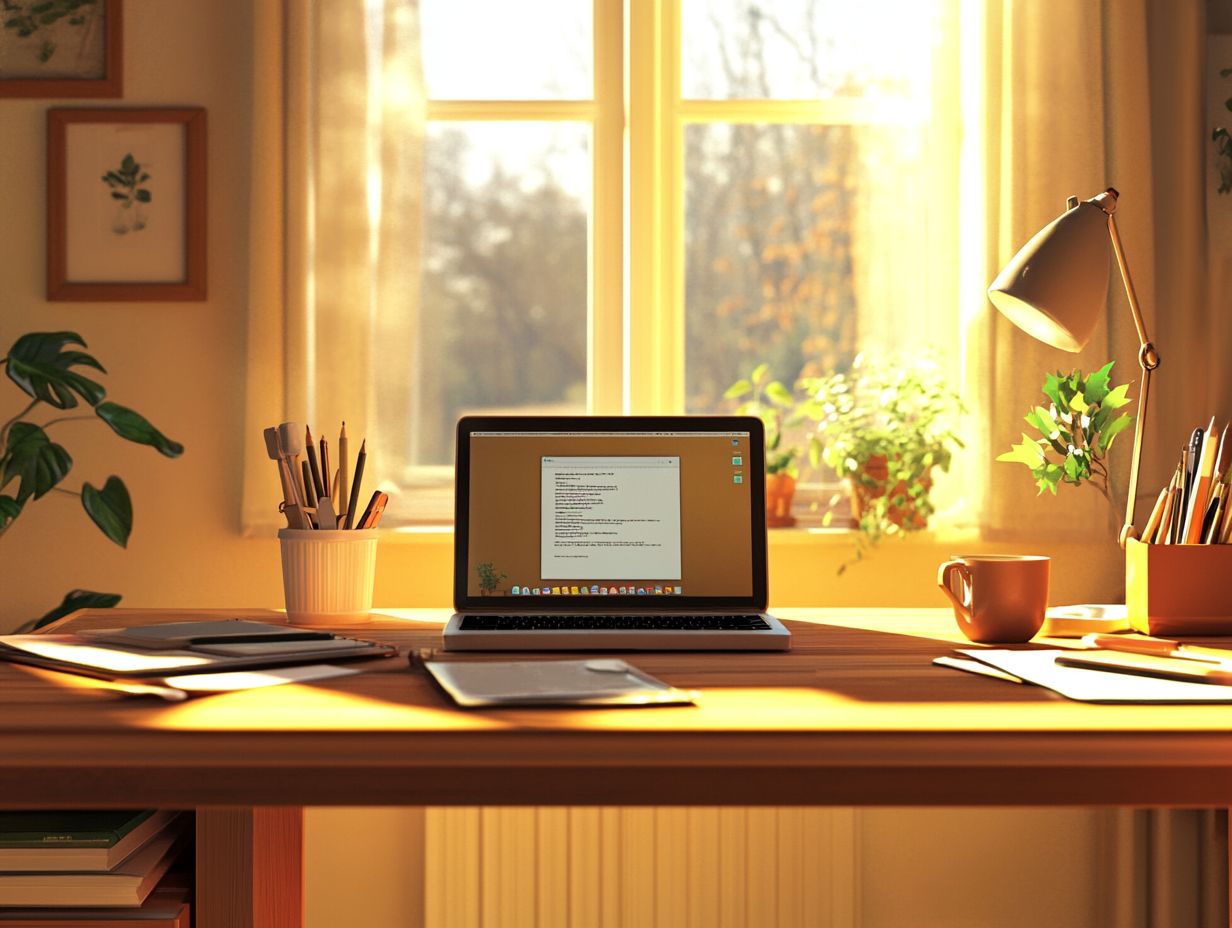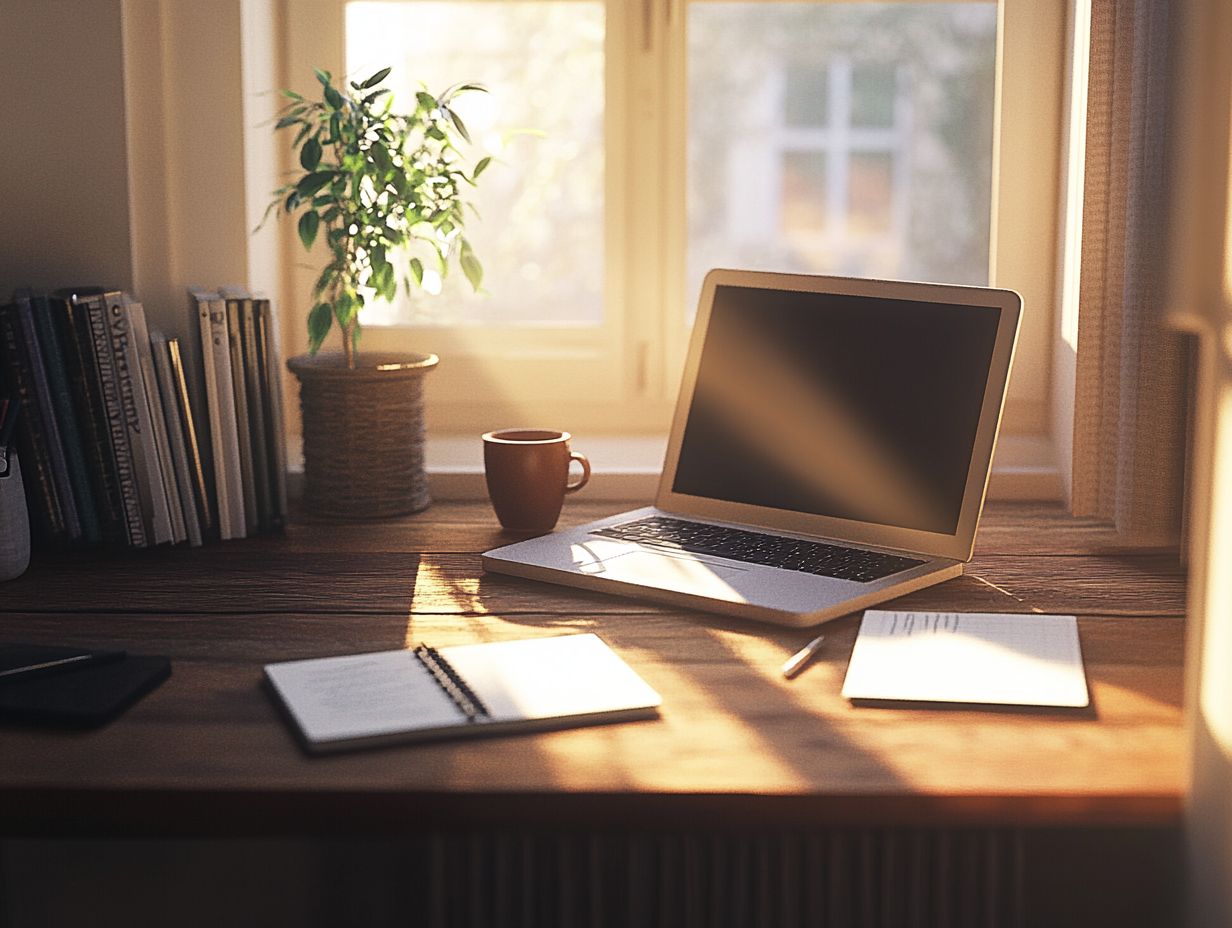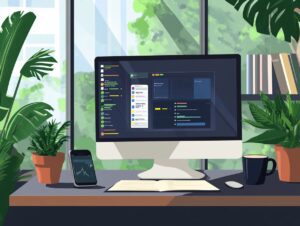Productivity is not merely a buzzword; it is essential for achieving both personal and professional success. We have put together this simple story with Tips on How to Be More Productive at Home.
Whether you are working from home or attempting to balance various household tasks, creating a productive environment can significantly impact your effectiveness. This includes optimizing your home office setup to minimize distractions and enhance focus.
This article will explore key strategies to optimize your workspace, establish effective routines, set clear goals, and manage your time wisely through effective planning and task prioritization.
Additionally, it will emphasize the importance of self-care to maintain balance and prevent burnout, highlighting the significance of scheduling breaks and practising mindfulness.
Are you ready to enhance your productivity and improve your work-life balance? Let s delve into these strategies together.
Why Productivity is Important
Productivity is vital in today s fast-paced environment, as it significantly influences our capacity to achieve both personal and professional goals, maintain a healthy work-life balance, and ultimately enhance our overall quality of life. It encompasses effective time management, task prioritization, and the motivation to persevere through challenges. Recognizing the significance of productivity can lead to better mental health and well-being, as individuals learn to allocate their energy efficiently and focus on what truly matters, resulting in a more fulfilling life experience.
By adopting various productivity strategies such as setting realistic deadlines, breaking tasks into manageable parts, and leveraging technological tools one can considerably enhance personal efficiency. This improvement fosters a sense of accomplishment and bolsters self-esteem, both of which are essential for sustaining positive mental health.
A well-structured schedule allows individuals to allocate time for relaxation and hobbies, thereby alleviating stress and preventing burnout. In essence, mastering time management is not merely about accomplishing more; it is about creating a harmonious balance that enables individuals to pursue their aspirations while also enjoying life s simple pleasures.
Creating a Productive Environment
Establishing a productive environment is essential for anyone aiming to enhance their efficiency and focus, whether working from home or in any other workspace. A well-organized and thoughtfully designed workspace can help minimize distractions and encourage better concentration, ultimately resulting in higher productivity levels.
By implementing effective organization strategies and paying attention to ergonomics, individuals can significantly improve their work experience. Additionally, being mindful of environmental factors such as lighting and noise can further contribute to a productive atmosphere that nurtures creativity and overall well-being.
Designing a Workspace for Optimal Productivity
Designing a workspace that enhances productivity involves careful consideration of layout, organization, and the integration of tools that support focus and efficiency. Key elements include choosing ergonomic furniture that promotes proper posture and minimizes discomfort, alongside implementing digital organization strategies to maintain a clutter-free environment.
Additionally, incorporating inspiring elements such as personal touches or a curated selection of resources can transform the workspace into a motivating setting that helps individuals achieve their goals and boost creativity.
To further optimize the workspace, it is important to think about how furniture arrangement can facilitate movement and provide easy access to essential tools. The effective use of technology is also crucial, as software applications and digital planners can streamline tasks and reduce the time spent searching for information.
Moreover, investing in quality lighting and incorporating plants can significantly alleviate stress and enhance concentration. Adding personal elements like artwork, motivational quotes, or photographs not only reflects individual style but also cultivates a positive atmosphere, invigorating the creative process.
Ultimately, a well-designed workspace is essential for boosting productivity and fostering a sense of well-being.
Minimizing Distractions to Be More Productive at Home
Minimizing distractions is essential for maintaining focus, particularly in a remote work environment where personal and professional spaces often overlap. To enhance productivity, individuals should take the time to identify potential distractions and put effective strategies in place to manage them. This might involve setting clear boundaries with family members during work hours, utilizing technology to track time, or even considering a digital detox to limit screen exposure.
By actively addressing distractions, one can improve energy management and cultivate an environment conducive to meaningful work.
Establishing a designated workspace that is free from clutter is also beneficial, as physical organization significantly influences mental clarity and the overall work environment.
Additionally, incorporating techniques like the Pomodoro Technique where work is divided into intervals with short breaks in between can help maintain focus while aligning with one s natural attention span. Encouraging regular breaks to refresh the mind is equally important in preventing burnout.
Each individual should evaluate their unique situation and adapt these strategies to meet their specific needs, ultimately fostering a more productive and fulfilling work experience. Techniques like digital detox can also be beneficial for maintaining focus.
Establishing a Routine
Establishing a routine can significantly enhance productivity by providing the necessary structure and consistency to our daily activities. This approach leads to improved time management and better energy levels.
When we incorporate daily rituals and habits into our lives, we create a framework that encourages self-discipline and helps us prioritize tasks more effectively. A well-defined routine not only supports us in achieving our goals but also fosters a sense of accomplishment and motivation. This, in turn, drives us to maintain a productive lifestyle, even when faced with challenges.
Benefits of a Routine
The advantages of establishing a routine extend well beyond simple time management; they are fundamental in cultivating a productivity mindset that can greatly improve our daily lives. A consistent routine contributes to effective stress management by offering a sense of predictability and diminishing decision fatigue, which allows individuals to concentrate better on their tasks.
Additionally, accountability mechanisms can be woven into these routines to ensure steady progress toward both personal and professional goals, fostering self-motivation and enhancing overall productivity. This can be further supported through goal tracking and feedback mechanisms.
By integrating structured habits into their daily schedules, individuals often find themselves feeling less overwhelmed and more in control. For instance, dedicating specific times each day for deep work can effectively cultivate focus, creating uninterrupted periods for essential tasks.
Techniques like the Pomodoro Technique, which divides work into manageable intervals followed by brief breaks, can enhance concentration and maintain high motivation levels, promoting both task completion and efficiency.
As individuals design routines that incorporate these focus strategies, they are likely to improve their ability to manage stress, ultimately leading to more consistent and satisfying outcomes in both their work and personal lives.
Tips for Sticking to a Routine
Sticking to a routine may appear to be a daunting task, but with the right strategies, it can become quite manageable. Self-discipline and commitment are essential elements in maintaining a productive routine, as they enable individuals to stay focused on their daily goals and objectives.
Additionally, incorporating flexibility into your routine allows for necessary adjustments, ensuring that it remains relevant and achievable as life circumstances evolve, which in turn supports a sustainable approach to personal development and healthy habits.
To effectively cultivate self-discipline, it is beneficial to set specific and realistic goals that can guide daily efforts. Breaking larger tasks into smaller, more manageable steps can help alleviate feelings of overwhelm and encourage a sense of progress.
Establishing a consistent schedule enables both the mind and body to adapt, creating a sense of comfort within the routine. However, it is also essential to allow for spontaneity; being open to re-evaluating your goals and adjusting your routine as necessary is vital.
This balance of structure and adaptability not only reinforces the commitment to self-improvement but also fosters resilience, making the journey toward personal goals more rewarding and less intimidating. Incorporating feedback and communication can further enhance this process.
Setting Goals and Priorities to Be More Productive at Home
Setting goals and priorities is essential for both personal and professional development, allowing individuals to concentrate their efforts on what truly matters. By identifying clear personal goals and using effective task prioritization techniques, one can streamline their workflow and improve accountability.
This organized approach not only clarifies objectives but also boosts motivation and cultivates a productivity mindset. As a result, it becomes easier to maintain focus and achieve the outcomes that are desired.
Identifying and Tracking Goals
Identifying goals is a crucial first step in the journey of personal development and achievement, as it provides essential direction and purpose to our efforts. Whether one is focusing on professional aspirations or personal milestones, establishing clear and attainable goals enables individuals to implement effective focus techniques, motivation strategies, and planning strategies to reach their targets.
By reflecting on their values and priorities, individuals can outline a roadmap that guides their daily actions and decisions toward fulfilling these objectives, employing time management and goal tracking along the way.
This process begins with a thoughtful assessment of what truly matters to each person, ensuring that the goals they set resonate with their core beliefs. Engaging in activities such as journaling, meditation, or discussing ideas with trusted mentors can greatly assist in this discovery phase, helping with personal development and outcome-oriented planning.
Once values are clearly identified, individuals can prioritize goals that align with those values, creating a powerful synergy that enhances motivation and commitment. This concerted clarity not only streamlines the planning process but also strengthens focus techniques, enabling individuals to overcome distractions, procrastination, and allocate their resources more efficiently.
Ultimately, when personal goals are aligned with intrinsic values, individuals find themselves on a more fulfilling and purpose-driven journey toward achievement.
Creating a Priority List for Task Prioritization
Creating a priority list is a highly effective strategy for task prioritization and time management, enabling individuals to concentrate on what truly matters in their daily lives. By utilizing checklists or to-do lists, one can manage deadlines and streamline their workflow, ensuring that urgent tasks are addressed while still making progress on long-term goals. This organized approach supports the implementation of various work strategies that enhance both productivity and accountability.
There are several effective methods for creating this priority list. A good starting point is a daily or weekly checklist, where tasks can be categorized based on their urgency and importance. Another useful method is time blocking to allocate specific times for focused tasks.
- For example, employing the Eisenhower Matrix provides a visual representation of tasks, making it easier to decide what to tackle first.
- Setting deadlines for each task also helps maintain a steady pace and prevents those last-minute scrambles.
By consistently reviewing and adjusting priorities, individuals can adapt to changing circumstances, maintain focus, and cultivate a sense of accomplishment. Additionally, using project management tools can support this process. Ultimately, this structured method of prioritization not only improves time management but also contributes to a more productive and balanced lifestyle.
Effective Time Management Strategies
Effective time management strategies are crucial for maximizing productivity and ensuring that individuals can successfully meet their personal and professional commitments, whether they are working from home or in an office setting.
By implementing scheduling techniques, utilizing time-tracking tools, and adopting various productivity hacks and motivation techniques, individuals can enhance their efficiency and create a more balanced approach to managing daily tasks.
These strategies not only help to minimize stress but also promote a greater sense of control over time, leading to improved focus, self-discipline, and the achievement of goals.
Tools and Techniques for Time Management and Productivity
Utilizing the appropriate tools and techniques for time management can significantly enhance productivity and assist individuals in staying focused on their goals, particularly in a remote work environment.
Incorporating methods such as the Eisenhower Matrix can be particularly beneficial, as it helps prioritize tasks based on urgency and importance. Additionally, using task management applications and productivity apps can ensure that attention is directed toward activities that yield the highest impact.
Additionally, tools like digital calendars, workspace organization tools, and task management applications allow for seamless integration of scheduling and reminders, enabling easy adjustments as priorities change.
By establishing a daily or weekly review process and incorporating feedback mechanisms, individuals can refine their routines and improve accountability.
These strategies not only promote a disciplined approach to work but also foster a sense of control and accomplishment, ultimately leading to a more effective and fulfilling professional life. This is especially true in remote team settings where virtual collaboration and online meetings are essential.
Maintaining Balance and Avoiding Burnout
Maintaining balance in life is crucial for preventing burnout and ensuring sustained productivity, particularly in a world where work and personal responsibilities frequently intersect.
It is important to prioritize self-care and implement effective stress management techniques, as these can greatly enhance energy levels and overall well-being.
By establishing clear boundaries between work and personal time, individuals can foster a healthier work-life balance, which enables them to recharge and concentrate on both their professional and personal goals.
Importance of Self-Care and Wellness
Self-care is far more than a luxury; it is an essential aspect of maintaining mental health and overall well-being, particularly when striving for a healthy work-life balance and efficient energy management. By engaging in mindfulness practices and prioritizing emotional health, individuals can significantly enhance their resilience to stressors and improve productivity.
Acknowledging the importance of self-care and integrating it into daily routines enables individuals to navigate the demands of both their professional and personal lives more effectively, ultimately leading to sustained success and happiness.
Self-care includes a wide array of activities that nurture the mind, body, and spirit, allowing individuals to recharge and regain focus. Simple practices such as taking brief breaks throughout the workday, engaging in deep breathing exercises, or establishing a meditation routine can make a substantial impact on one s emotional well-being. Regularly practicing self-care contributes to a positive mindset and helps in managing life s challenges more effectively.
These mindfulness techniques not only provide clarity and improve concentration but also foster a sense of peace, which facilitates greater effectiveness in managing daily tasks.
Emphasizing self-care promotes a healthier lifestyle, enabling individuals to build stronger relationships and enhancing their capacity to cope with life s challenges.
Avoiding Overworking
Avoiding overworking is essential for maintaining long-term productivity and preventing burnout. By setting clear boundaries around work hours and incorporating energy breaks, individuals can mitigate the negative effects of overworking and foster a healthier approach to productivity. Recognizing when it’s time to step back and recharge allows individuals to implement productivity strategies that enhance their workflow while preserving their energy and motivation. Employing mindfulness techniques and stress management strategies can also aid in maintaining a sustainable work culture.
Establishing specific work hours creates a framework that enables individuals to disconnect from professional obligations and focus on their personal well-being. It’s also important to integrate regular energy breaks throughout the day, as these intervals can boost creativity and improve concentration. Setting boundaries and decluttering your workspace are additional methods to maintain a healthy work environment.
Techniques such as the Pomodoro Technique, which involves alternating short bursts of focused work with brief breaks, can be particularly effective. Additionally, understanding the importance of stress management techniques such as mindfulness and deep breathing exercises can enable individuals to handle their professional responsibilities without sacrificing their mental health.
In this manner, one can cultivate a sustainable work culture that emphasizes balance and wellness, fostering better productivity levels and work-life harmony.
Frequently Asked Questions
What are some tips for staying productive while working from home?
1. Set a schedule and stick to it: Create a routine for yourself and follow it consistently to maintain structure and focus.
2. Create a designated workspace: Having a specific area for work can help increase productivity and separate work from personal life.
3. Minimize distractions: Turn off notifications and avoid checking social media or emails constantly to avoid distractions.
4. Take breaks: It’s important to take short breaks throughout the day to avoid burnout and maintain motivation.
5. Prioritize tasks: Make a list of tasks and prioritize them based on urgency and importance to stay on top of your workload.
6. Communicate with others: If you are working with a team, make sure to communicate regularly and effectively to stay on track with projects.
How can I maintain a healthy work-life balance and productivity while working from home?
1. Set boundaries: Clearly define your work hours and stick to them to avoid working outside of designated times.
2. Make time for self-care: Schedule breaks and activities for self-care, such as exercise, meditation, or hobbies, to maintain a healthy balance.
3. Disconnect after work: Once your workday is over, disconnect from work and focus on personal time and activities.
4. Separate work and personal space: If possible, have a separate workspace from your living space to avoid bringing work into your personal life.
5. Communicate with your employer: If you feel overwhelmed or overworked, communicate with your employer to find a solution that works for both parties.
6. Don’t be afraid to say no: Learn to say no to tasks or projects that may interfere with your work-life balance.
What are some common distractions and productivity challenges that can hinder productivity while working from home?
1. Social media: Constant notifications and scrolling can be a major distraction and disrupt workflow, making it difficult to maintain focus.
2. Household chores: It can be tempting to do household tasks during work hours, but it’s important to stick to your work schedule and routine.
3. Family or roommates: If you live with others, it’s important to communicate boundaries and find ways to minimize interruptions during work hours to maintain a productive work environment.
4. Technology: Technical issues or spending too much time on non-work-related tasks can decrease productivity and disrupt your workflow.
5. Lack of structure: Working from home can lack the structure of a traditional office, which can lead to distractions and decreased productivity. Setting a daily routine and practising self-discipline can help overcome this.
6. Poor time management: Without a set schedule or routine, it can be easy to get off track and waste time on tasks that are not a priority. Implementing time management techniques such as time blocking and task prioritization can help improve efficiency.
How can I combat feelings of loneliness while working from home and improve my work-life balance?
1. Schedule virtual social time: Set up virtual hangouts with friends or coworkers to stay connected and combat feelings of isolation using communication tools like online meetings and virtual collaboration platforms.
2. Join online communities: Join online communities or groups related to your industry or personal interests to connect with others and share experiences, fostering a sense of community and personal development.
3. Take breaks outside: Take short breaks to get some fresh air and sunlight, which can improve mood, combat loneliness, and boost concentration levels.
4. Use video conferencing: Instead of relying solely on emails or phone calls, use video conferencing to see and interact with others, promoting better communication and feedback.
5. Find a remote work buddy: Partner up with a remote coworker or friend who also works from home to stay accountable and connected, enhancing motivation and accountability.
6. Seek professional help: If feelings of loneliness persist, consider seeking professional help and talking to a therapist or counsellor to improve your overall wellness and mental health.
What are some strategies for staying motivated and maintaining productivity while working from home?
1. Set goals and rewards: Set achievable goals for yourself and reward yourself when you reach them to stay motivated. Effective goal setting and goal tracking can help maintain a positive mindset.
2. Find accountability: Share your goals and progress with others to stay motivated and hold yourself accountable. Accountability can be boosted through remote collaboration and feedback mechanisms.
3. Change up your environment: If you feel stuck in a rut, try working from a different location, such as a coffee shop or park, to switch things up. A change in environment can spark creativity and new ideas.
4. Break tasks into smaller chunks: Large tasks can be overwhelming, so break them into smaller, more manageable tasks to stay motivated. This can also help with task management and project management.
5. Take breaks to recharge: Make sure to take breaks throughout the day to avoid burnout and recharge your motivation. Incorporate self-care and mindfulness practices during these breaks to maintain energy levels.
6. Reflect on your progress: Look back on your accomplishments and progress to stay motivated and see how far you’ve come. This reflection can foster a results-oriented mindset and continued personal development.
What are some ways to maintain work productivity and manage distractions while also caring for children at home?
1. Set a flexible schedule: Create a schedule that allows for flexibility and adjust it based on your child’s needs. Effective scheduling can help balance work and personal responsibilities.
2. Plan activities for children: Have activities and games planned for your children to keep them occupied while you work, ensuring minimal distractions and better concentration.
3. Take advantage of nap times: Use nap times as an opportunity to get work done without distractions, optimizing your workflow and productivity levels.
4. Communicate with your employer: Communicate with your employer about your situation and find a solution that works for both parties. Remote work arrangements can benefit from open communication and collaboration tools.
5. Work during non-traditional hours: Consider working early in the morning or late at night when your children are asleep to maximize productivity. This approach can help in managing energy levels and focus techniques.
6. Ask for help: Don’t be afraid to ask for help from your partner, family, or friends when needed to balance work and childcare responsibilities. Task delegation and support can enhance your workflow and efficiency.










